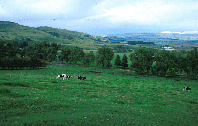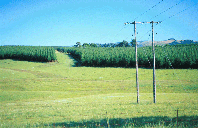Home
Study Sites
Research
Results
Publications
Links
Contacts
Research on Conservation Farming

Introduction
A comprehensive assessment of conservation farming must measure and analyse various aspects of both farming systems and the natural and social environments. In order to achieve this, we needed to evaluate the following:
- Relationships between farming systems and the patterns of biodiversity and the processes that generate and maintain biodiversity.
- The effect of farming systems on the ecological processes and ecosystem services that sustain farming productivity.
- The differences in production between different farming systems.
- The economics of various farming systems.
- The social factors influencing decision making by farmers.
Specific research foci
Back to top
The broad objectives given above necessitated us taking a multidisciplinary approach to the research programme. The table below lists the specific research areas that we adopted to address the broad project objectives.
| Biodiversity assessments | - plants - insects - selected higher fauna |
| Ecological processes | - soil turnover - nutrient cycling - water infiltration/runoff - herbivore dynamics - seed dispersal - seed predation - productivity - carbon flow/sequestration |
| Ecosystem services | - vegetation productivity - vegetation phenology - vegetation resilience - vegetation palatability - vegetation structure - wool vegetative matter assessment - predator diet breadth analysis - landscape heterogeneity analysis |
| Ecological economics | - assessment of farm economics - assessment of alternative/hidden income sources - assessment of ecosystem processes and services - economic modelling |
| Social dimension | - assessment of perceptions about land use - identification of factors affecting spread of innovations - assessment of relationships between farmers & extension staff - facilitation of learning & knowledge transfer |
Research projects
The research foci listed above were addressed by work from several research projects. In addition, many of the projects addressed more than one research area. In particular, work on biodiversity assessment and ecosystem processes frequently overlapped. In the research project summaries presented below, we have grouped the biodiversity assessment and ecological processes projects where they overlap.
Biodiversity assessments
Hamish Robertson and Simon van Noort of Iziko South African Museum undertook a survey of ants, bees and wasps (Hymenoptera) in the four study sites. This study assesses biodiversity of Hymenoptera on various landscape and vegetation types, and under different land management practices.
Biodiversity and ecological processes
The National Botanical Institute undertook research that aimed at characterising biodiversity at the landscape level and to determine the driving factors of vegetation dynamics at sites in Bokkeveld and Nama Karoo. The impacts of grazing and disturbance by porcupines and the effects of different grazing systems and farm layout on biodiversity received particular attention in this module.
Christy Bragg, from the University of Cape Town, did her MSc thesis in Conservation Biology, on porcupine foraging ecology in Nieuwoudtville. For more details, click here.
The Terrestrial Ecology Research Unit (TERU) of the University of Port Elizabeth had several researchers working on quantifying the changes in ecosystem function and biodiversity on farms with different management histories (under the supervision of Richard Cowling and Graham Kerley). This work took place in the Eastern Cape Thicket Biome, and aims to improve the understanding of the dynamics of succulent thicket. For more details, click here.
Tim O'Connor of Tim O'Connor and Associates assessed the impact in the southern Drakensberg of different land uses on biodiversity at the community and species level for plants and for selected taxa of animals. Specific attention is given to characteristic species such as threatened, endemic, and functionally important species. He also investigated the effect of different land uses on ecosystem functioning with specific reference to primary production, nutrient stocks and flows, and carbon sequestration. Click here for more information.


Leon Theron of the National Botanical Institute compared the impacts of two different grazing management systems on plant and insect diversity on several farms in the Nama Karoo. Stock farmers in the Karoo region generally use either the Department of Agriculture's group camp system or Allan Savory's Holistic Management Method. Both systems rotate stock through camps, but differ markedly in stocking rates and grazing periods. This project compares each system in terms of its impact on biodiversity conservation and maintenance of ecosystem functions. The project also assesses the impact of distance from watering points on vegetation. For more details, click here.
Ecological processes
Anthony Mills and Martin Fey of the Department of Soil Science at the University of Stellenbosch analysed the impacts of landuse management practices on carbon sequestration and soil chemistry at the four study sites. Their study assessed how changes to soils strongly affect associated ecosystems, and to what level soil changes limit the capacity of ecosystems to revert to pre-agricultural status.
Ecosystem services
Patrick O'Farrell of the National Botanical Institute examined sites in the Bokkeveld and Nama Karoo to assess the interaction between farming practices and ecosystem processes and services (or disservices). The study aims to determine what ecosystem services and processes are required for various farming practices, on what factors ecosystem services depend, and how farm management impacts on ecosystem services. This research attempts to quantify effects and to translate them into a financial value.
Ecological economics
Jane Turpie of Southern Waters Ecological Research and Consulting and her project team, in consultation with researchers at each site, evaluated the economic implications of conservation farming. Information from all parts of the project were drawn together into an ecological-economic model. This was used to identify and quantify the functional relationships between ecosystems and the goods and services they provide to farmers and to society as a whole. Scenario analyses were used to evaluate the implications of the application of conservation farming methods on a broader scale within the study areas. For more information on this module, click here.
Social dimension
Bettina Koelle of Indigo and her project team conducted interviews with farmers in the four study sites in order to gain an understanding of attitudes towards farming, so as to understand what might improve or hinder the spread of conservation farming among the farming community. The potential of agricultural extension staff to assist farmers with conservation-oriented land management was assessed. Finally, they facilitated the adoption of a "learning approach" to land management so as to encourage farmers to adopt new land use management practices and to enable researchers to become more effective facilitators of learning on the part of land users.
These pages use CSS style sheets.
If you experience problems viewing them, please turn style sheet support in your browser off, or download a new browser.